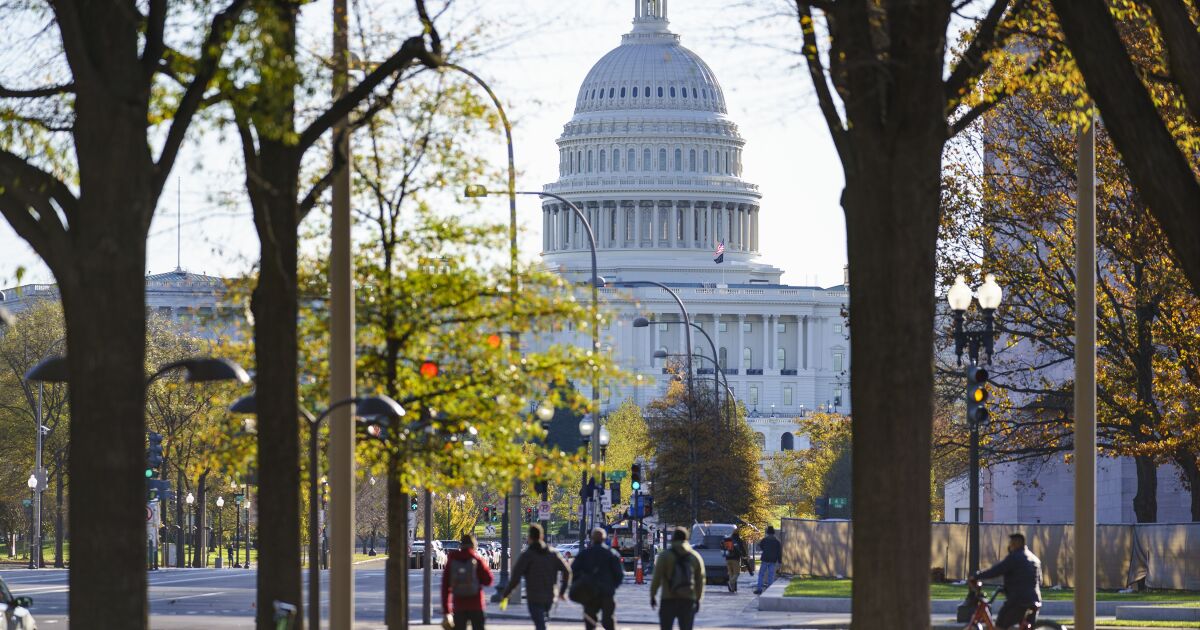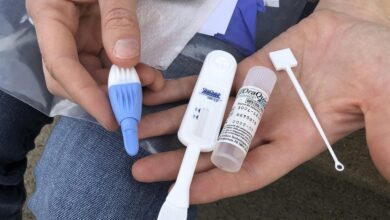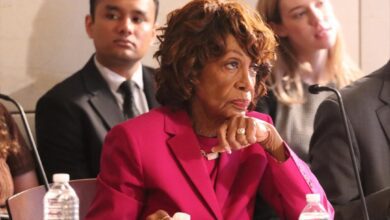Democrats’ plan to take control of Congress could depend on Southern California

Democratic hopes to seize control of the U.S. House of Representatives next year at a pivotal moment for policy decisions about reproductive and LGBTQ+ rights, education and the economy may hinge on Southern California.
Despite the state’s liberal bent, California has the most competitive congressional races in the nation — an anomaly created by the state’s independent map-drawing process and sheer size.
“We could be outcome determinative. We could be absolutely critical,” said Darry Sragow, a veteran Democratic strategist who is the publisher of the nonpartisan California Target Book, which tracks the state’s congressional and legislative races. ”There are a number of districts that are capable of going one way or the other and they’re going to be hard fought and they’re going to be expensive and they’re going to matter.”
Of the 435 seats in the House, Democrats need to capture five held by Republicans next year to take back control of Congress. And they view many of their best opportunities in California.
“The three or four seats in Southern California that are in play could be the deciding factor in who controls Congress in 2024, 100%,” said Paul Mitchell, a Democratic redistricting expert. “That could end up being more than enough to get Democrats the majority in Congress.”
“In the rest of the country, so many districts are so polarized, so partisan,” drawn to ensure a Republican or a Democrat will win, he noted. “Our districts are less polarized, there’s more swinginess to them, which makes them more valuable in the congressional control question.”
The nonpartisan Cook Political Report, which has tracked House and Senate races for decades, rates nine of the state’s 52 congressional districts as competitive, the most of any state in the nation.
Most are in swaths of California that voted for President Biden yet elected a GOP congressional representative — districts that both parties consider prime battlegrounds in 2024. While a few are in the Central Valley, the bulk are in Southern California.
“These are bright blue districts that we need to play in. We need to have the candidates who can message, knock on doors and can generate voter enthusiasm and who can deliver these votes,” said Rep. Pete Aguilar (D-Redlands), chairman of the House Democratic Caucus.
Sragow attributes the number of competitive congressional seats in California to the state’s independent map-drawing process for political boundaries, including congressional districts, approved by voters in 2010 to replace the traditional partisan maps previously created by lawmakers. Most congressional districts across the country are still determined by state lawmakers who often try to tailor the maps to their political advantage if they hold power in their legislatures.
“There aren’t that many competitive seats anymore. There has been this incredible shift in much of the country toward gerrymandered congressional districts where the outcome is predetermined,” Sragow said. “There’s just not a lot of swing. So if you’re looking to pick up seats, California is a place you can do that.”
“This is one of the genuinely few competitive playing fields for House seats,” he said.
But Democrats face conundrums in many of the contests.
One of the most competitive races in the nation is an Orange County district being vacated by Rep. Katie Porter, who is running to replace retiring U.S. Sen. Dianne Feinstein.
Porter, a prodigious fundraiser, spent nearly $29 million to narrowly hang onto her seat last year against former GOP Assemblyman Scott Baugh.
This election, the Republican is expected to receive stronger financial support and his Democratic rivals lack Porter’s fundraising prowess. The race was further scrambled when the candidate Porter endorsed, state Sen. Dave Min, was arrested on suspicion of driving under the influence in Sacramento. Joanna Weiss, an attorney like Porter, is also running for the seat and has the backing of former Rep. Harley Rouda, who planned to run for the seat until he suffered a brain injury.
North of Porter’s district, Democrats have long salivated — unsuccessfully — over the region represented by GOP Rep. Mike Garcia, which includes Santa Clarita, the Antelope Valley and part of the San Fernando Valley. The once-solidly Republican stronghold has grown more Democratic as Los Angeles residents moved there seeking affordable housing.
The district should be a solid pick-up opportunity for Democrats, but they have failed miserably three elections in a row. Strategists say a lack of investment by national Democrats was driven by both the expense of political advertising in Los Angeles, one of the most expensive media markets in the nation, and a lack of confidence in Garcia’s Democratic rival in the contests, Christy Smith. The former assemblywoman blasted her party for failing to back her in last year’s election.
Former Virgin Galactic CEO George Whitesides and Francisco Carrillo, who was wrongly convicted of murder and served two decades in prison before being released, are the Democrats now challenging Garcia.
GOP Rep. Michelle Steel, who represents a district that straddles Los Angeles and Orange counties with many Asian American voters, could also face a challenging reelection bid. Garden Grove City Councilwoman Kim Nguyen, a Democrat, announced her candidacy to represent the district that is home to many Vietnamese American voters.
In Riverside County, veteran Rep. Ken Calvert (R-Corona) will probably face former federal prosecutor Will Rollins in a competitive race. The redrawing of district lines resulted in the inclusion of a large number of liberal and gay voters in the Palm Springs area. Rollins is gay and regularly campaigns with his husband; Calvert has a history of voting against LGBTQ+ interests and his allies outed a Democratic rival in a 1994 campaign. Calvert, who said his view on gay rights has evolved and he now supports same-sex marriage, beat Rollins by fewer than 5 points last year, a result that may prompt national Democrats to invest in the race.
Other potentially competitive seats include those held by Reps. Mike Levin (D-San Juan Capistrano), and John Duarte (R-Modesto), David Valadao (R-Hanford) and Josh Harder (D-Turlock) in the Central Valley.
Democrats are optimistic about their chances protecting Levin and Harder and ousting Garcia, Steel, Valadao, Duarte and Calvert because 2024 is a presidential election year, a time when voter turnout is higher and young and minority voters who favor their party are traditionally more likely to cast ballots.
But GOP leaders countered that they have bucked this trend in congressional contests in recent years.
“In 2016, we didn’t lose a single race. In 2020, we picked up four seats,” said Jessica Millan Patterson, chair of the state Republican Party. “We’re winning in seats Biden won by 10 points.”
And Democrats agreed that even if they flipped these districts next year, they may be in play the following election cycle.
“These seats will help determine who controls the House for the rest of the decade,” Mitchell said.




